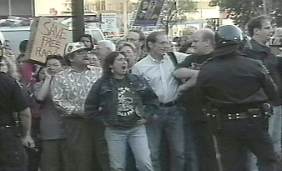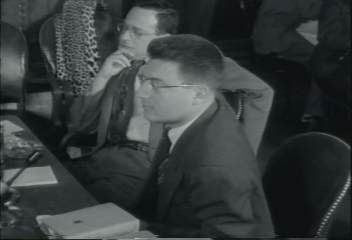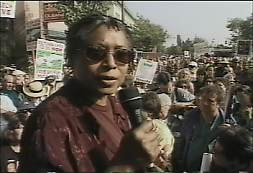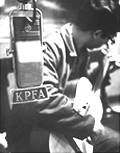 | |
From KPFA On The Air. |
|
The film KPFA On The Air arrives at
a good time. Until quite recently, little information was readily available
about the Pacifica Foundation and its stations—somewhat surprising
given the organization's ground-breaking role in public broadcasting for
more than half-a-century.
Now those curious about the organization that celebrated
its 50th anniversary with an enormous public meltdown can choose between
several books and this exceptional documentary to get at least an inkling
of what drives one of the world's most vital—and volatile—media
operations.
It's a tribute to filmmakers Veronica
Selver and Sharon Wood (and a comment on the complexity of the story they
tell) that the Pacifica Foundation reportedly disliked their work enough
to bar its five owned-and-operated stations from using KPFA On The
Air as a fundraising premium—while the "Save Pacifica" activists
currently doing battle with the network's management felt it did not go
far enough. But I'm getting ahead of myself!
Before going any further with this review I must, in the interest of full disclosure, reveal that my own history with the Pacifica Foundation goes back more than 20 years. The community radio station with which I was very involved in college depended heavily on Pacifica's national news feed. I still remember my excitement when they picked up a few of my own stories for distribution. After graduating I spent a number of rewarding months working out of Pacifica's National News Bureau in Washington DC. A decade later, my stint as assistant manager at Pacifica radio station WBAI in New York City was at the time the toughest job I ever hated and, in retrospect, one of the most meaningful times of my life. And now, my association with Pacifica continues through my work with WRPI in Troy NY—one of the sixty-odd affiliated stations that air the network's news and information programming.
Such is the importance of the organization that
a large percentage of the people involved in public broadcasting in the
United States have at one time or another had experience with Pacifica.
The exact number is difficult to determine—although former Senator
Larry Lee Presser of South Dakota attempted to do just that a few years
ago when he demanded that National Public Radio release lists of its employees
with ties to Pacifica in a move strongly reminiscent of Senator Joseph McCarthy's
probe of Pacifica itself (footage of which is included in KPFA On The
Air). But again I'm getting ahead of myself!
The Pacifica Foundation was developed in the late
1940s by Lewis Hill, a pacifist who used his time in a remote conscientious
objector camp during World War II to develop organizing strategies with
other non-violent activists. Hill had some experience as a journalist, enough
to convince him that the compromises inherent in commercial broadcasting
corrupt its content. The world's first listener-sponsored station, KPFA
in Berkeley, was the result of Hill's conviction that truth-telling is the
path to peace—and that financial independence is the path to truth.
One of KPFA On The Air's enduring contributions
to our understanding of broadcasting history is the skillful telling of
the story of Pacifica's early years. It is one thing to read in a communications
studies text that Pacifica champions a style of reporting now called "advocacy
journalism"—it is quite another to see the Cold War roots of one of
the boldest experiments in broadcasting.
The story of Pacifica Radio is of course
inseparable from its context, so the documentary is rich with images ranging
from archival footage of pacifists in the contientious objectors (C.O.)
internment camps to the Iran Contra hearings on Capital Hill. Longtime
KPFA supporter Alice Walker's crisp narration holds the disparate elements
together. One of my favorite parts of the documentary comes when her scripted
voice track is replaced briefly by footage of Walker at a "Save KPFA"
rally.
The camera work is nicely done, as Walker seems to speak to the
film's audience.
This moment, in which the narrator's traditionally dispassionate
role is jarringly questioned as Walker literally steps into the documentary,
symbolizes Pacifica Radio's own role in redefining the relationship between
journalism and activism.
Historian Mathew Lasar (author of Pacifica Radio: The Rise of an Alternative Network) is an engaging presence in this production;
his comments show both a passion for Pacifica and a nuanced understanding
of institutional history. The story of Pacifica is rife with problems that
defy easy answers; it is a credit to everyone involved in making this film
that it strives to present the complexity of its subject rather than making
a run at determining who was "right" at any particular moment. And it is
this very characteristic that gives KPFA On The Air its evergreen
appeal, for after watching it we understand that it is the ideas behind
Pacifica that create the conflict we see today—and that conflict is
the one constant at Pacifica. What, after all, is conflict other than the
sign of process underway? Certainly it might be better if Pacifica and similar
organizations could achieve their goals without it, but discord also can
be seen as part and parcel of an organizing project that strives to bring
disparate, disenfranchised members of a society together in a physical space
with finite resources. That Pacifica's founder, a committed pacifist, took
his own life—due in no small part to the unending struggles at KPFA—reveals
a great deal about Pacifica today, where conflict is as much a part of the
landscape as it was 50 years ago.
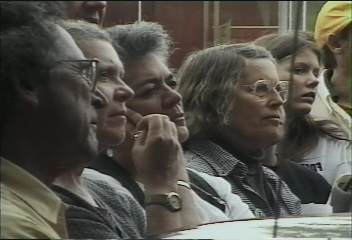 |
Concerned listeners and contributors protest
attempts to restict their access to KPFA. |
|
From modest beginnings as the troubled proprietor
of a single radio station, Pacifica is now the troubled proprietor of five
major market stations—KPFA in the San Francisco Bay area, KPFK in Los
Angeles, KPFT in Houston, WPFW in Washington and WBAI in New York City.
It also supplies programming to independent non-commercial radio stations
throughout the United States and Canada, and on the Web. Pacifica pioneered
a form of non-commercial broadcasting that inspired a global community media
movement, as well as introduced the listener-sponsorship model familiar
to supporters of National Public Radio and Public Broadcasting System stations.
To this day Pacifica stations refuse to air commercial announcements, even
as its progeny fall increasingly under the sway of corporate "underwriting"
essentially indistinguishable from advertising.
Yet the mere mention of the word Pacifica is almost
guaranteed to evoke a flinch, a giggle, or both, from those in the know.
The organization, notwithstanding its extraordinary history and loyal listeners,
is synonymous with internal strife and crippling internal politics. As I
write this, headlines from New York City tell the story of the sudden and
seemingly arbitrary firing of WBAI's general manager—her reward for
more than twenty years of service. Other similarly tenured staff were also
dismissed and several unpaid staff members (the volunteer life-blood of
Pacifica and other community-based stations) have been banned. Reminiscent
of mid-1970s bloodbaths from which the Foundation has not yet fully recovered
a quarter century later, Pacifica is enveloped by internecine warfare that
threatens, as usual, destruction from within. This is so much a part of
the story that Pacifica will almost certainly be in crisis of one kind or
another regardless of when you read this. But why?
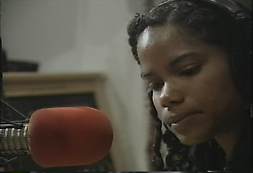 |
Blacks, Latinos, and Asians increased their
presence at KPFA from the 1970s through the 1990s. |
|
Much of the value of the film KPFA On The Air lies in the filmmakers' attempt to reveal the nature of these conflicts, without yielding to the urge to make definitive judgements about causality. (This, of course, makes them unpopular among anyone with an axe to grind, which is seemingly anyone within hearing distance of a Pacifica station.)
It is clear from viewing the film that broadcasting
unpopular views on issues as controversial and diverse as McCarthyism, the
Vietnam War, Civil Rights, Gay Liberation and so on is central to the Pacifica
tradition—so it should surprise no one that the stations are themselves
so often the center of controversy. Pacifica has proven its worth to successive
waves of social justice activists, but the extent to which the stations
also support marginalized and avant-garde culture is clearly illustrated
through numerous interviews and archival clips featuring artists Langston
Hughes, Allen Ginsburg, Lorraine Hansbury and many others.
The Pacifica Foundation's trajectory over the past
five decades is illustrated as well as anyone could in a film of less than
an hour. We hear KPFA's earliest recorded broadcasts and see the program
schedule, which illustrate an allegiance to British Broadcasting Corporation-style
high culture and objective journalism. The harrowing encounter with McCarthyism,
tempered with Beat poetry, gives way to footage of the Free Speech Movement
in Berkeley and all-out opposition to the war in Indochina. And, in a particularly
illuminating sequence, the filmmakers explore Pacifica's transition from
radio for social movements into radio by social movements,
as people of color and other activists demand a voice within the organization.
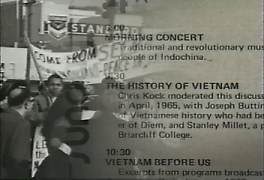 |
Radio for social movements,
reflected in KPFA's program schedule.
28.8K | 56K | Cable/T1 |
|
I was a college freshman in 1977 when
I read in the New York Times about the radio station whose staff had seized
control by barricading themselves in the transmitter shack atop the Empire
State Building. It was Pacifica Radio's WBAI. I thought then that
it was an absolutely astounding act—who (in this country) cares enough
about radio to do such a thing? I know now that is was a desperate effort
by people fighting to retain their place in an institution that had become
part of their lives.
When I began work at WBAI a decade later, I walked
into a radio station that had clearly lost its way. In many ways WBAI (like
Pacifica as a whole), had been at the center of the counterculture of the
1960s but, by the late 1970s, New York City had changed in ways with which
the station had not been able to keep pace. Noncommercial stations like
WNYC had siphoned off the classical music listeners; the ground-breaking
news magazine All Things Considered redefined the meaning of National
Public Radio. Suddenly there was competition for the white, upscale, college-educated
audience that Pacifica had originally cultivated and drawn.
Simultaneously, the demographic makeup of WBAI's
signal area became far more culturally diverse—and the hot button political
issues of the day were those that reflected concerns of the city's African
American and Latino residents. A logical strategic move would seem to be
re-focusing the station's attention on this new, under-served audience.
And in fact, the seizure of WBAI's transmitter in 1977 was precipitated
by the hiring of program director Pablo Guzman (former Minister of Information
for the Young Lords) who intended to do just that.
To a large extent the problem then, as now, was
one of organizational development—the inability in a politically-charged,
largely volunteer-staffed environment to manage change. The stereotypical
white, middle class men who dominated Pacifica in its first three decades
were understandably loathe to move on—and the abysmal management that
has been Pacifica's hallmark did little to help. The result, as I experienced
it in the late 1980s, was an environment rife with racial tension—one
in which entrenched producers (who, because of the station's history, were
largely white) jealously protected their hard-won resources from newcomers
(mostly people of color) with a management ill prepared to mediate.
But overall, it is the sorry state of
broadcasting in the United States that is to blame for Pacifica's troubles.
With the bulk of available radio spectrum squandered on utter tripe, for millions
of people their only hope of getting heard is on one of the few handfuls
of stations dedicated to ideas, not profits. The incursion of commercial
broadcasting ideology into the non-profit realm has intensified the pressure for strict formatting, professionalization, and advertisements thinly disguised
as underwriting. They have become the order of the day even at formerly community-oriented
stations. In this ever-more-wired world we need more access to media—and
we're getting less.
Steve Pierce
Rensselaer Polytechnic Institute
~ End ~
Video Review of KPFA On The Air
Copyright © 2000, 2001 by The Journal for MultiMedia
History
Comments
| JMMH
Contents
|

